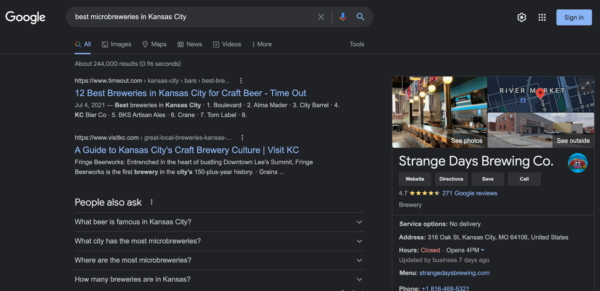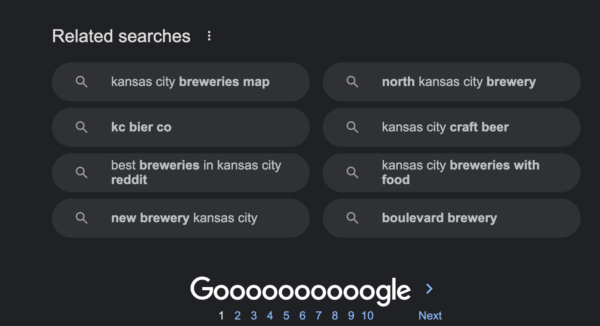
Addressing search engine optimization (SEO) as a business owner can be overwhelming. You want to grow your business, have a successful organic traffic strategy, and approach your marketing confidently. But sometimes, it can seem like there’s new SEO advice and best practices every few months.
How can you create content that constantly hits SEO goals without becoming an expert? Learning about semantic SEO and search intent can make a difference in how you think about your strategy.
Google uses more than 200 ranking factors. Thus, it’s vital to understand the type of content Google prioritizes and how its ranking system works to create valuable content that puts you in front of potential clients.
What is semantic SEO and search?
Google search today is the best it’s ever been for users. When you look for the name of your favorite song, that book title with the plot you barely remember, or even the nearest electrician, Google delivers almost every time. Ever wondered why that happens? The answer is semantic search. Google’s search mechanism is no longer solely keyword-based.
Semantic SEO is how marketers optimize their content to best fit the way Google “reads” what they post online. Understanding how Google gives users results makes creating content that will appear higher on search results more accessible.
How semantic search works
Semantic search includes much more than scanning text for keywords. Instead, Google uses machine learning to understand not just words in your query (or search) but also the relationships they have to each other.
This way, it looks for results that fit the same type of context. Before, marketers had to prepare for the possibility of searchers misspelling the company name or using an abstract word structure. Now, Google can still give you accurate results even when the person searching makes a few mistakes.
Furthermore, Google uses additional key information to give you the results that best match your search intent. If you’re looking for an electrician, for instance, it uses local SEO data to provide you with a result in your area.
What does search intent mean, exactly? Let’s go through it below.
What is search intent?
Search intent, also called user intent, refers to the type of result you’re looking for when inserting a query into Google. There are three types of search intent that Google categorizes: informational, navigational, and transactional.
- Informational intent: The searcher is looking to learn about something. When you search the name of a company, an animal, or a fruit, Google will assume you want to know more about it and treat your search as informational.
- Navigational intent: The searcher is looking to find something. Suppose you are searching for a website, a particular link, or an article. In that case, Google searches for the best match, treating your search as navigational.
- Transactional intent: The searcher is looking to purchase something. If you’re looking for “winter boots,” for instance, Google doesn’t assume you’re looking to learn about them or find winterboots.com. It knows that, generally, people search that query when they want to buy something.
Because of search intent, learning how your customers are searching for your product or service will be vital when trying to rank high on search engine results pages (SERPs).
For example, say you’re relying only on transactional search intent for when people are ready to purchase. As your potential customers or leads do research and get informed on what you sell, they could find your competitor first. Thus, incorporating all three categories in your SEO strategy can increase your chances of attracting a customer to you first.
Finding good vs. great keywords
What do search intent and semantic SEO have to do with you getting more organic search traffic to your website? Now that you know how Google matches results with queries let’s go over how to use this information to find and target great keywords.
What makes a good keyword?
Good keywords are everything you’ve heard about if you’ve performed previous SEO audits. They are often searched on Google, but the results aren’t ideal. So the competition is low.
Long-tail keywords are good to focus on because they’re usually specific. This means that few sources have created content that’s good enough to fully satisfy the searcher’s intent.
What makes a great keyword?
Great keywords take everything from your previous research and take it one step further. Those competitive keywords, phrases, or long-tail keywords are just the beginning.
First, you’ll match those to a search intent and then make sure that semantic search will match your content to the query according to the intent. Let’s go through an example to make the process clearer.
Suppose your long-tail keyword is “best microbreweries in Kansas City.” Writing a post about it and including the keyword a few times won’t be enough to get you ranked. What you’ll want to do first is search the query yourself and observe the search results. Ask yourself the following questions:
- What type of intent does Google assume the searcher has when entering this query? Transactional? Informational? Navigational?
- How helpful are the results that are currently ranking? Do they satisfy the search intent?
- Does the current content also answer the “people also ask” section? Does it address related searches?
- How can you improve upon what’s already ranking?
- How strong are the pages that are currently ranking? Look for their domain authority and backlinks using Moz Link Explorer.

Since Google is associating and learning about how all of these keywords are related, it also provides related searches at the bottom of the results page. Use those related searches to direct your content toward the query in the best way. Here’s what the related searches look like:

Assessing the competition
When we compare how the results match the query, related searches, and the “people also ask” section, we see that there’s an opportunity. The top two ranking posts are listicles of breweries that hardly reference any other searches related to the main query. However, they do have a strong presence online, and therefore have a lot of authority — a metric used by Google when choosing which sites to rank on the top results.
Time Out, for example, has a domain authority (DA) of 91/100 and Visit KC has a DA of 61/100. Depending on your industry, you can rank above them, but it could be challenging. The best you can do is create higher-quality content and work on your backlink strategy. Backlinking, as an SEO practice, gets other related sites to link back to your site or a specific page, increasing its authority.
Turn a good keyword into a great one
Fine-tuning your SEO strategy to include both semantic SEO and search intent will amplify your content. These practices cater to how Google ranks the quality and relevance of your content to queries and intentionally makes the searcher — a potential lead — a priority. Both actions will get noticed and benefit you.
Now that you’ve learned about these marketing practices, it’ll be much easier for you to approach your keyword strategy to attract more leads to your business. To begin incorporating them, put yourself in the shoes of your ideal customers. Start by researching queries they make as they try to find solutions to their problems.
Then, tap into the way your target audience thinks to find that good keyword. Once you’ve found one that you’re satisfied with, start looking into search intent and semantic search results to assess how competitive it is. Put this practice into play to convert a good keyword into a great one, increasing the range of your existing and future content.




